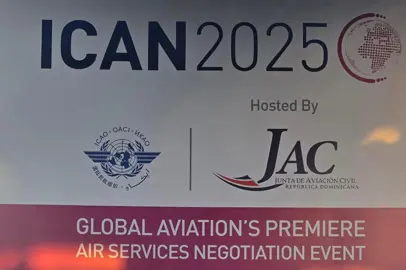06 April 2020
IATA Releases 2019 Airline Safety Report
A passenger could take a flight every day for 535 years before experiencing an accident with one fatality on board
The International Air Transport Association (IATA) announced the release of the 2019 Safety Report showing continuing improvements in airline safety compared to 2018 and to the preceding five years.
All major 2019 safety performance indicators improved compared to 2018 and to the average of the 2014-2018 period as shown below:
| 2019 | 2018 | 5-year average (2014-2018) |
|
|---|---|---|---|
|
All accident rate
(accidents per one million flights)
|
1.13 or 1 accident
every 884,000 flights
|
1.36 or 1 accident
every 733,000 flights
|
1.56 or 1 accident
every 640,000 flights
|
| Total accidents | 53 | 62 | 63.2 |
| Fatal accidents | 8 fatal accidents (4 jet and 4 turboprop) with 240 fatalities |
11 fatal accidents
with 523 fatalities
|
8.2 fatal accidents/year
with an average of 303.4 fatalities each year
|
| Fatality risk | 0.09 | 0.17 | 0.17 |
| Jet hull losses
(per one million flights)
|
0.15 which is equal
to 1 major accident for every 6.6 million flights
|
0.18 (one major accident
for every 5.5 million flights)
|
0.24 (one major accident
for every 4.1 million flights)
|
|
Turboprop hull losses
(per one million flights)
|
0.69 (1 hull loss
for every 1.45 million flights)
|
0.70 (1 hull loss
for every 1.42 million flights)
|
1.40 (1 hull loss
for every 714,000 flights)
|
“The safety and wellbeing of our passengers and crew is aviation’s highest priority. The release of the 2019 Safety Report is a reminder that even as aviation faces its deepest crisis, we are committed to making aviation even safer. Based on the 2019 fatality risk, on average, a passenger could take a flight every day for 535 years before experiencing an accident with one fatality on board. But we know that one accident is one too many. Every fatality is a tragedy and it is vital that we learn the correct lessons to make aviation even safer,” said Alexandre de Juniac, IATA’s Director General and CEO.
Jet hull loss rates by region of operator (per million departures)
Five regions showed improvement in 2019 compared to the previous five years (2014-2018) in terms of the jet hull loss rate.
Five regions showed improvement in 2019 compared to the previous five years (2014-2018) in terms of the jet hull loss rate.
| region | 2019 | 2014-2018 |
|---|---|---|
|
Global
|
0.15 | 0.24 |
|
Africa
|
1.39 | 1.01 |
|
Asia Pacific
|
0.00 | 0.30 |
|
Commonwealth of Independent States (CIS)
|
2.21 | 1.08 |
|
Europe
|
0.00 | 0.13 |
|
Latin America and the Caribbean
|
0.00 | 0.57 |
| Middle East and North Africa | 0,00 | 0,44 |
| North America | 0,09 | 0,16 |
|
North Asia
|
0.15 | 0.00 |
Turboprop hull loss rates by region of operator (per million departures)
All regions except for Latin America and the Caribbean showed improvement when compared to their respective five-year rates. Accidents involving turboprop aircraft represented 41.5% of all accidents in 2019 and 50% of fatal accidents.
All regions except for Latin America and the Caribbean showed improvement when compared to their respective five-year rates. Accidents involving turboprop aircraft represented 41.5% of all accidents in 2019 and 50% of fatal accidents.
| region | 2019 | 2014-2018 |
|---|---|---|
|
Global
|
0.69 | 1.40 |
|
Africa
|
1.29 | 5.20 |
|
Asia Pacific
|
0.55 | 0.87 |
|
Commonwealth of Independent States (CIS)
|
15.79 | 16.85 |
|
Europa
|
0.00 | 0.15 |
|
America Latina e Caraibi
|
1.32 | 0.26 |
| Middle East and North Africa | 0.00 | 3.51 |
| North America | 0,00 | 0.67 |
|
North Asia
|
0.00 | 5.99 |
IOSA
In 2019, the all accident rate for airlines on the IOSA registry was nearly two times better than that of non-IOSA airlines (0.92 vs. 1.63) and it was more than two-and-a-half times better over the 2014-18 period (1.03 vs. 2.71). All IATA member airlines are required to maintain their IOSA registration. There are currently 439 airlines on the IOSA Registry of which 139 are non-IATA Members.
Fatality Risk
Fatality risk measures the exposure of a passenger or crew to a catastrophic accident with no survivors. The calculation of fatality risk does not consider aircraft size or how many were on board. What is measured is the percentage of fatalities among those on-board. This is expressed as fatality risk per millions of flights. The 2019 fatality risk of 0.09 means that on average, a person would have to travel by air every day for 535 years before experiencing an accident with at least one fatality. On average, a person would have to travel every day for 29,586 years to experience a 100% fatal accident.
IATA (International Air Transport Association) represents some 290 airlines comprising 82% of global air traffic.
Safety Fact Sheet
IATA defines an accident as an event where all of the following criteria are satisfied:
Person(s) have boarded the aircraft with the intention of flight (either flight crew or passengers).
The intention of the flight is limited to normal commercial aviation activities, specifically scheduled/charter passenger or cargo service. Executive jet operations, training, maintenance/test flights are all excluded.
The aircraft is turbine powered and has a certificated Maximum Take-Off Weight (MTOW) of at least 5,700KG (12,540 lbs.).
The aircraft has sustained major structural damage exceeding $ 1 million or 10% of the aircraft's hull reserve value, whichever is lower, or has been declared a hull loss.
A hull loss is an accident in which the aircraft is destroyed or substantially damaged and is not subsequently repaired for whatever reason including a financial decision of the owner.
IATA defines an accident as an event where all of the following criteria are satisfied:
Person(s) have boarded the aircraft with the intention of flight (either flight crew or passengers).
The intention of the flight is limited to normal commercial aviation activities, specifically scheduled/charter passenger or cargo service. Executive jet operations, training, maintenance/test flights are all excluded.
The aircraft is turbine powered and has a certificated Maximum Take-Off Weight (MTOW) of at least 5,700KG (12,540 lbs.).
The aircraft has sustained major structural damage exceeding $ 1 million or 10% of the aircraft's hull reserve value, whichever is lower, or has been declared a hull loss.
A hull loss is an accident in which the aircraft is destroyed or substantially damaged and is not subsequently repaired for whatever reason including a financial decision of the owner.
There were also 7 fatalities on the ground in the accident involving Busy Bee Congo.
Edited by Alisè Vitri
Source text: IATA Press Office
Visual: Sisterscom.com / Shutterstock
All rights reserved. All rights reserved.
Copyright © Sisterscom.com
You might be interested in
Useful Info

Authority
HyperTwin Leads the Evolution of Future Air Mobility
Enac: HyperTwin will help redesign the airspace in the coming years for drones, eVTOLs, advanced, urban, territorial, safe and sustainable air mobility
Useful Info

Authority
Airport infrastructures and air transport development: the focus of CESISP at Bicocca and the contribution of ENAC
At the University of Milano-Bicocca, CESISP analyzes the role of airport infrastructures for growth, public finance and the country's competitiveness; ENAC Director General D'Orsogna recalls infrastructural capacity as a lever of the "Italian model"
Useful Info

Authority
ENAC at ICAN 2025: bilateral agreements and a new boost to Italy's air connectivity
Agreements with Ethiopia, Saudi Arabia, El Salvador, the United Kingdom and the Dominican Republic; Negotiations opened with Luxembourg, Egypt, the United Arab Emirates, Zambia, Seychelles and South Africa

